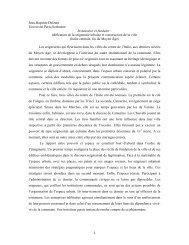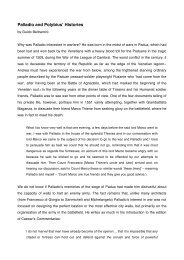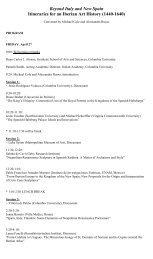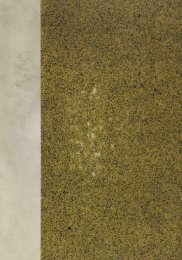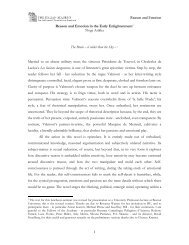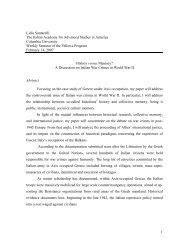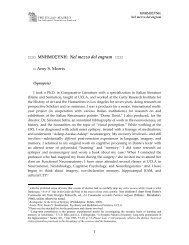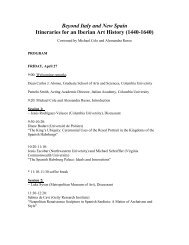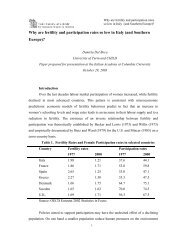2011-2012 - The Italian Academy - Columbia University
2011-2012 - The Italian Academy - Columbia University
2011-2012 - The Italian Academy - Columbia University
Create successful ePaper yourself
Turn your PDF publications into a flip-book with our unique Google optimized e-Paper software.
While at the <strong>Academy</strong> I have also benefited from meeting faculty<br />
members from the larger <strong>Columbia</strong> community such as Taylor<br />
Carman, Chris Peacocke and Akeel Bilgrami in the Philosophy Department,<br />
and Nina Tandon, Stuart Firestein and Sarah Woolley in<br />
Bio-engineering, Neuroscience & Biology. Besides my presentations<br />
at the internal seminars, I have given five different invited talks<br />
outside the <strong>Academy</strong>. <strong>The</strong>se talks created incredible interdisciplinary<br />
connections. Here I shall just mention an important collaboration<br />
that I have begun with psychologist Elizabeth Torres at Rutgers<br />
<strong>University</strong>, studying the kinematic differences between intentional<br />
and non-intentional movements and how the physical misdirection<br />
of magicians’ movements exploits our typical perceptual dynamics.<br />
But, perhaps most important, this year has given me the opportunity<br />
to deepen my own research projects. I continue to develop<br />
my doctoral research critically analyzing the implicit choices and<br />
theoretical frameworks surrounding the discovery and popularization<br />
of so-called mirror neurons. My seminar paper in the Fall<br />
focused on this research and on my alternative “social affordance”<br />
model of the neurological findings in question.<br />
<strong>The</strong> main idea is that our sensorimotor response to the perception<br />
of others’ actions cannot simply be seen as a local “mirroring”<br />
of the action types observed. Rather our neurological response<br />
must be seen as much more complex and context-dependent than<br />
hitherto admitted. I point to growing evidence that not only the<br />
intentional actions of others but also salient potential actions (affordances)<br />
of the self and the other are tracked as they are related<br />
to one another in a shared space. I am still working on some of the<br />
many consequences of the proposed “social affordance model” for<br />
our general understanding of social interactions, testing in developmental<br />
psychology, and the role of sensorimotor cognition in higher<br />
cognitive processes and pathologies such as autism.<br />
Another project that has sprung out of my “social affordance”<br />
thinking has to do with aesthetics experiences and what I call “the<br />
aesthetic stance.” I claim that we cannot simply look at the content<br />
of artworks as isolated stimuli and then check for correlating activities<br />
in the brain, but must analyze the layers and roles of “framing<br />
affordances” in different art forms, and try to understand the<br />
37 |





